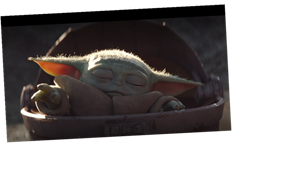When kicking back to watch a Star Wars spinoff, you might not expect to fall in love with a cute Baby Yoda. And yet that’s exactly what happened to, well, pretty much everyone the moment he graced the screen in the new Disney+ show, The Mandalorian. The way Baby Yoda peeked out of his little pod was enough to make the world declare its undying love. But what is it, exactly, about a green creature with pointy ears that we find so impossibly adorable?
It might seem obvious, due to his glistening eyes, tiny fingers, and the fact he’s sailing around in what’s essentially a floating crib. But there’s a scientific explanation for why you want to reach through the screen and squish him. According to several studies, we react this strongly to infantile features — like a large head, round face, and big eyes — so we’ll feel motivated to take care of the babies of the world, and thus increase their chances of survival.
"Any features that remind us of infants or babies will draw us in — it is our natural parental instincts to protect or at least feel connected to babies," Joshua Klapow, PhD, a clinical psychologist, tells Bustle. "This automatic, nurturing, and parental response is hardwired, keeps us connected to our young, and is generalized to the young of other species."
That’s why you might not be able to contain yourself around puppies or kittens either, thanks to their big eyes and round heads. All babies are vulnerable, so they need to be as cute as possible so we’ll scoop them up and make sure they’re OK. And Baby Yoda (or whoever he is) certainly gives off these same vibes. He watches, wide-eyed and swaddled, from afar as the Mandalorian fends off enemies, and even closes his pod at times to keep him safe.
Another study from Oxford University found that babies not only look cute, but appeal to our other senses by making charming sounds, and smelling good, too. While it’s anyone’s guess what odor Baby Yoda is giving off, he does make adorable noises. And it all amounts to a powerful biological force, researchers say, that appeals to all genders, as well as those with and without children.
"The Baby Yoda-like creature is not of our species but it is small, has large eyes, looks to be innocent, and looks to be young," Klapow says. "We can’t help ourselves — we are going to have our nurturing instinct triggered and most of us will find this creature quite cute." So, now that we know the science behind why Baby Yoda is so cute, let’s bask in the internet’s equally sweet reaction.
Folks have been sharing their love for him all over Twitter, and fan accounts have sprung up to share photos of Baby Yoda’s pinchable face. Many have vowed to protect him at all costs, which goes to show that protective biological force is strong — even with fictional green creatures.
He has brought Disney and Star Wars fans even more joy than they likely expected to experience, what with every show now at their fingertips thanks to the new streaming service. Add in Baby Yoda’s round eyes and earnest expression, and what more could you ask for?
Fans have been asking themselves why Baby Yoda is so cute. But we know. We know…
Tiny, bald, and green. And yet super cute all the same.
Adding to the joy are the tweets using Yoda’s syntax, which flips words around. Very adorable, it is.
We’ll hopefully get to see more of him as the rest of The Mandalorian unfolds. But for now, let’s take this moment to enjoy Baby Yoda being the cutest thing on the internet.
Studies Referenced:
Glocker, M. L., Langleben, D. D., Ruparel, K., Loughead, J. W., Gur, R. C., & Sachser, N. (2009). Baby Schema in Infant Faces Induces Cuteness Perception and Motivation for Caretaking in Adults. Ethology, 115(3), 257–263. doi: 10.1111/j.1439-0310.2008.01603.x
Morten L. Kringelbach, Eloise A. Stark, Catherine Alexander, Marc H. Bornstein, Alan Stein. On Cuteness: Unlocking the Parental Brain and Beyond. Trends in Cognitive Sciences, 2016; DOI: 10.1016/j.tics.2016.05.003
Expert:
Joshua Klapow, PhD, clinical psychologist
Source: Read Full Article
